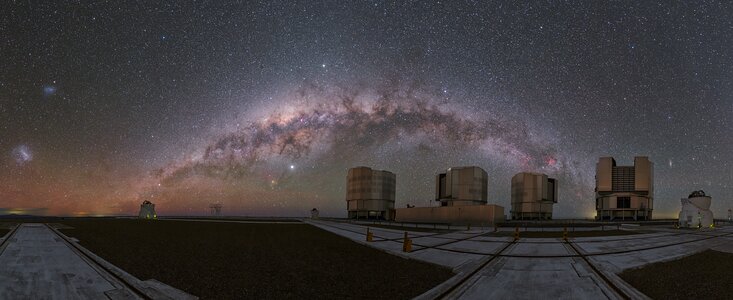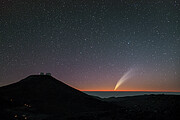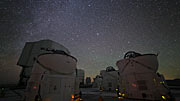Press Release
New ESO analysis confirms severe damage from industrial complex planned near Paranal
17 March 2025
An in-depth technical analysis by the European Southern Observatory (ESO) has evaluated the impact of the INNA megaproject on the facilities at the Paranal Observatory, Chile — and the results are alarming. The analysis reveals that INNA would increase light pollution above the Very Large Telescope (VLT) by at least 35% and by more than 50% above the south site of the Cherenkov Telescope Array Observatory (CTAO-South). INNA would also increase air turbulence in the area, further degrading conditions for astronomical observations, while vibrations from the project could seriously impair the functioning of some of the astronomical facilities, like the Extremely Large Telescope (ELT), at the Paranal Observatory.
In January, ESO publicly raised the alarm about the threat posed to the world's darkest and clearest skies, those of ESO’s Paranal Observatory, from the industrial megaproject INNA. The project — by AES Andes, a subsidiary of the US power company AES Corporation — includes multiple energy and processing facilities, spread over an area of more than 3000 hectares, the size of a small city. Its planned location is just a few kilometres from the Paranal telescopes.
A preliminary analysis done at the time revealed that, due to its size and proximity to Paranal, the INNA project posed significant risks to astronomical observations. Now, a detailed technical analysis has confirmed that INNA’s impact would be devastating and irreversible.
Blinding light pollution
According to the new, detailed analysis, the industrial complex would increase light pollution above the VLT, which is about 11 km from the planned INNA location, by at least 35% above the current artificial-light baseline levels. Another of the Paranal facilities, ESO’s ELT, would see the light pollution above it increase by a minimum of 5%. This increase already represents a level of interference incompatible with the conditions required for world-class astronomical observations. The impact on the skies above the CTAO-South, located just 5 km from INNA, would be the most significant, with light pollution going up by at least 55%.[1]
“With a brighter sky, we severely limit our ability to directly detect Earth-like exoplanets, observe faint galaxies, and even monitor asteroids that could cause damage to our planet,” says Itziar de Gregorio-Monsalvo, ESO’s Representative in Chile. “We build the largest and most powerful telescopes, in the best place on Earth for astronomy, to enable astronomers worldwide to see what no one has ever seen before. Light pollution from projects like INNA doesn't just hinder research, it steals our shared view of the Universe.”
For its technical analysis, a team of experts led by ESO Director of Operations Andreas Kaufer joined forces with Martin Aubé, a world-leading expert on sky brightness at astronomical sites, to run simulations using the most advanced light-pollution models. As input, the simulations used publicly available information provided by AES Andes when submitting the project for environmental assessment, which states the complex will be illuminated by over 1000 light sources.
“The light-pollution figures we are reporting assume that the project will install the most modern available luminaries in a way that minimises light pollution. However, we are concerned that the inventory of light sources planned by AES is not complete and fit for purpose. In that case, our already alarming results would underestimate the potential impact of the INNA project on the Paranal sky brightness,” Kaufer explains.
He adds that the calculations assume clear-sky conditions. “We would get even worse light pollution if we considered cloudy skies,” he says. “While Paranal is cloud-free most of the year, many astronomical observations can still be performed when there are thin cirrus clouds — and in this case the light-pollution effect is amplified since nearby artificial lights strongly reflect off the clouds.”
Turbulence ahead
The technical analysis looked into other impacts from the project, such as the increase in atmospheric turbulence, the effects of vibrations on the delicate telescope equipment, and dust contamination of the sensitive telescope optics during construction. All of these would further deepen the impact of INNA on Paranal’s capabilities for astronomical observation.
In addition to the dark and clear skies, Paranal Observatory is the world’s top site for astronomy thanks to its exceptionally steady and stable atmosphere – it has what astronomers call excellent seeing conditions or very low “twinkling” of astronomical objects caused by turbulence in Earth's atmosphere. With INNA, the best seeing conditions could deteriorate by up to 40%, in particular due to the air turbulence caused by the project’s wind turbines.
Another worry is the impact of the vibrations caused by INNA on the VLT Interferometer (VLTI) and the ELT, which are both extremely sensitive to micro-seismic noise. The technical analysis reveals that INNA’s wind turbines could produce an increase in these micro-vibrations of the ground that is large enough to impair the operations of these two world-leading astronomical facilities. Dust during construction is also problematic as it settles on the telescope mirrors and obstructs their view.
“Taken together, these disturbances seriously threaten the current and long-term viability of Paranal as a world-leader in astronomy, causing the loss of key discoveries about the Universe and compromising Chile’s strategic advantage in this area,” says de Gregorio-Monsalvo. “The only way to save Paranal’s pristine skies and protect astronomy for future generations is to relocate the INNA complex.”
Furthermore, INNA's infrastructure is likely to encourage the development of an industrial hub in the area, which could turn Paranal into an unusable site for top-level astronomical observations.
“ESO and its Member States are fully supportive of energy decarbonisation. For us Chile should not have to make a choice between hosting the most powerful astronomical observatories and developing green-energy projects. Both are declared strategic priorities by the country and are fully compatible — if the different facilities are located at sufficient distances from one another,” says ESO Director General Xavier Barcons.
Citizen Participation Process
The full technical report will be submitted to the Chilean authorities later this month, as part of the Citizen Participation Process (PAC) in INNA’s environmental impact assessment, and made public at that time, before the deadline of 3 April. In addition to this press release, ESO is making an executive summary of the report public in advance.
“We are extremely grateful for the support we’ve received from the Chilean and worldwide research communities, and from our ESO Member States. We also thank the Chilean authorities for looking into this matter. We are more committed than ever to working together to protect the irreplaceable Paranal skies,” concludes Barcons.
Notes
[1] The baseline levels refer to the current artificial sky brightness, caused by artificial lights. The sky brightness calculations were done in the visible light (in the V band centred at 550 nm) and assuming an observation direction of 45-degree elevation above the horizon towards the south.
More information
The European Southern Observatory (ESO) enables scientists worldwide to discover the secrets of the Universe for the benefit of all. We design, build and operate world-class observatories on the ground — which astronomers use to tackle exciting questions and spread the fascination of astronomy — and promote international collaboration for astronomy. Established as an intergovernmental organisation in 1962, today ESO is supported by 16 Member States (Austria, Belgium, Czechia, Denmark, France, Finland, Germany, Ireland, Italy, the Netherlands, Poland, Portugal, Spain, Sweden, Switzerland and the United Kingdom), along with the host state of Chile and with Australia as a Strategic Partner. ESO’s headquarters and its visitor centre and planetarium, the ESO Supernova, are located close to Munich in Germany, while the Chilean Atacama Desert, a marvellous place with unique conditions to observe the sky, hosts our telescopes. ESO operates three observing sites: La Silla, Paranal and Chajnantor. At Paranal, ESO operates the Very Large Telescope and its Very Large Telescope Interferometer, as well as survey telescopes such as VISTA. Also at Paranal ESO will host and operate the Cherenkov Telescope Array South, the world’s largest and most sensitive gamma-ray observatory. Together with international partners, ESO operates ALMA on Chajnantor, a facility that observes the skies in the millimetre and submillimetre range. At Cerro Armazones, near Paranal, we are building “the world’s biggest eye on the sky” — ESO’s Extremely Large Telescope. From our offices in Santiago, Chile we support our operations in the country and engage with Chilean partners and society.
Links
- Executive summary of ESO technical analysis on the impact of the INNA project
- Photos of Paranal
- INNA infographics
- January press release
Contacts
Francisco Rodríguez
ESO Media Relations Officer
Santiago, Chile
Tel: +56 2 2463 3151
Email: francisco.rodriguez@eso.org
Bárbara Ferreira
ESO Media Manager
Garching bei München, Germany
Tel: +49 89 3200 6670
Email: press@eso.org
Our use of Cookies
We use cookies that are essential for accessing our websites and using our services. We also use cookies to analyse, measure and improve our websites’ performance, to enable content sharing via social media and to display media content hosted on third-party platforms.
ESO Cookies Policy
The European Organisation for Astronomical Research in the Southern Hemisphere (ESO) is the pre-eminent intergovernmental science and technology organisation in astronomy. It carries out an ambitious programme focused on the design, construction and operation of powerful ground-based observing facilities for astronomy.
This Cookies Policy is intended to provide clarity by outlining the cookies used on the ESO public websites, their functions, the options you have for controlling them, and the ways you can contact us for additional details.
What are cookies?
Cookies are small pieces of data stored on your device by websites you visit. They serve various purposes, such as remembering login credentials and preferences and enhance your browsing experience.
Categories of cookies we use
Essential cookies (always active): These cookies are strictly necessary for the proper functioning of our website. Without these cookies, the website cannot operate correctly, and certain services, such as logging in or accessing secure areas, may not be available; because they are essential for the website’s operation, they cannot be disabled.
Functional Cookies: These cookies enhance your browsing experience by enabling additional features and personalization, such as remembering your preferences and settings. While not strictly necessary for the website to function, they improve usability and convenience; these cookies are only placed if you provide your consent.
Analytics cookies: These cookies collect information about how visitors interact with our website, such as which pages are visited most often and how users navigate the site. This data helps us improve website performance, optimize content, and enhance the user experience; these cookies are only placed if you provide your consent. We use the following analytics cookies.
Matomo Cookies:
This website uses Matomo (formerly Piwik), an open source software which enables the statistical analysis of website visits. Matomo uses cookies (text files) which are saved on your computer and which allow us to analyze how you use our website. The website user information generated by the cookies will only be saved on the servers of our IT Department. We use this information to analyze www.eso.org visits and to prepare reports on website activities. These data will not be disclosed to third parties.
On behalf of ESO, Matomo will use this information for the purpose of evaluating your use of the website, compiling reports on website activity and providing other services relating to website activity and internet usage.
Matomo cookies settings:
Additional Third-party cookies on ESO websites: some of our pages display content from external providers, e.g. YouTube.
Such third-party services are outside of ESO control and may, at any time, change their terms of service, use of cookies, etc.
YouTube: Some videos on the ESO website are embedded from ESO’s official YouTube channel. We have enabled YouTube’s privacy-enhanced mode, meaning that no cookies are set unless the user actively clicks on the video to play it. Additionally, in this mode, YouTube does not store any personally identifiable cookie data for embedded video playbacks. For more details, please refer to YouTube’s embedding videos information page.
Cookies can also be classified based on the following elements.
Regarding the domain, there are:
- First-party cookies, set by the website you are currently visiting. They are stored by the same domain that you are browsing and are used to enhance your experience on that site;
- Third-party cookies, set by a domain other than the one you are currently visiting.
As for their duration, cookies can be:
- Browser-session cookies, which are deleted when the user closes the browser;
- Stored cookies, which stay on the user's device for a predetermined period of time.
How to manage cookies
Cookie settings: You can modify your cookie choices for the ESO webpages at any time by clicking on the link Cookie settings at the bottom of any page.
In your browser: If you wish to delete cookies or instruct your browser to delete or block cookies by default, please visit the help pages of your browser:
Please be aware that if you delete or decline cookies, certain functionalities of our website may be not be available and your browsing experience may be affected.
You can set most browsers to prevent any cookies being placed on your device, but you may then have to manually adjust some preferences every time you visit a site/page. And some services and functionalities may not work properly at all (e.g. profile logging-in, shop check out).
Updates to the ESO Cookies Policy
The ESO Cookies Policy may be subject to future updates, which will be made available on this page.
Additional information
For any queries related to cookies, please contact: pdprATesoDOTorg.
As ESO public webpages are managed by our Department of Communication, your questions will be dealt with the support of the said Department.



